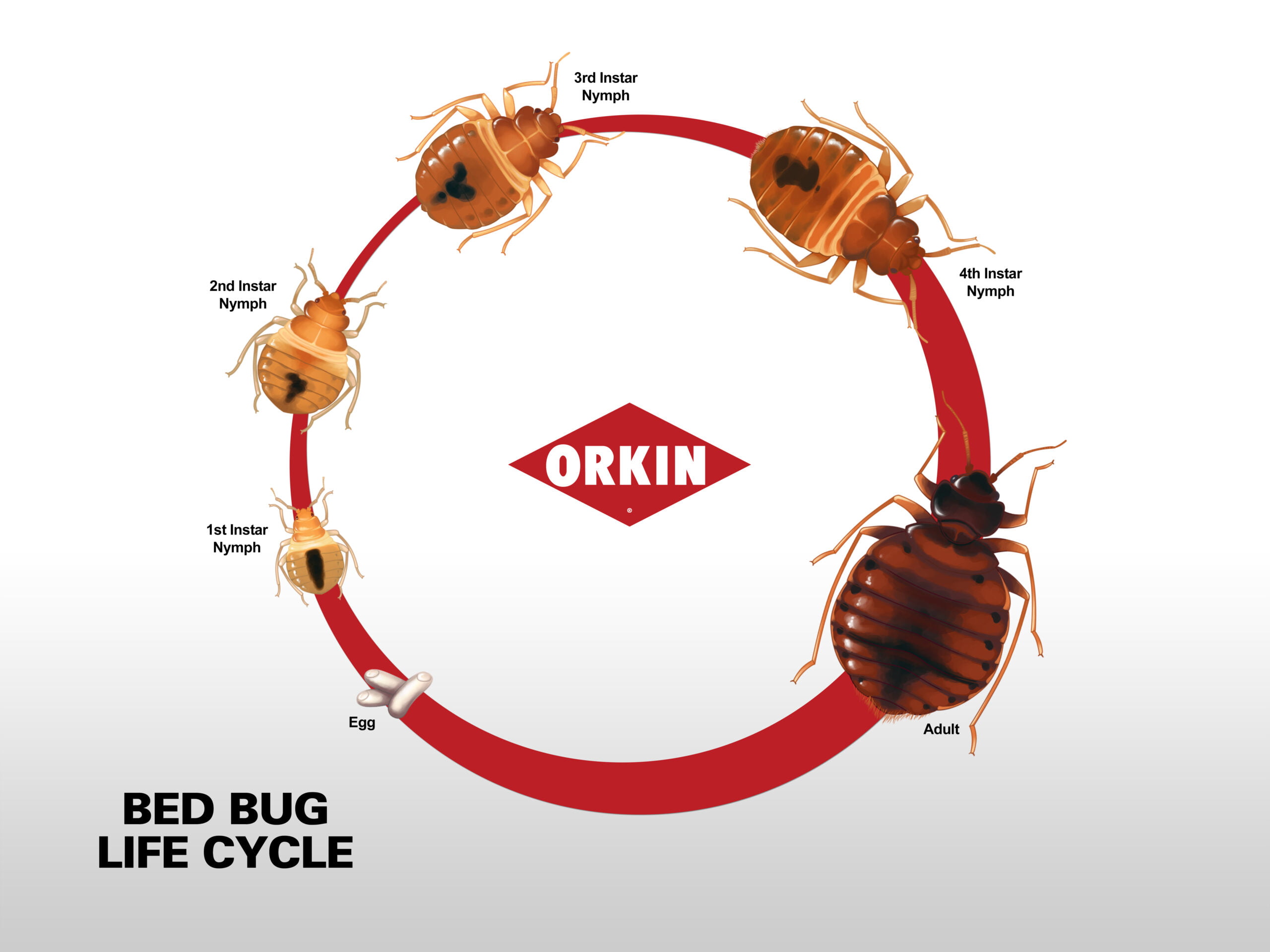Bed bugs take about 20 days to grow from egg to adult under ideal conditions. The growth cycle of bed bugs varies depending on temperature, humidity, and availability of food.
In optimal conditions, egg hatches in about 6-10 days, nymphs mature in 5 weeks, and adults can live up to a year. Proper identification and treatment methods are crucial to prevent a bed bug infestation from worsening. It’s essential to take prompt action if you suspect a bed bug issue to eradicate them effectively.
Understanding the growth timeline of bed bugs can help in implementing the right strategies for control and prevention. The key is early detection and intervention to avoid a full-blown infestation.
Life Cycle Of Bed Bugs
- Bed bugs start their life cycle as tiny white eggs.
- Eggs are usually laid in clusters or rows by adult females.
- The incubation period of bed bug eggs is approximately 6 to 10 days.
- Nymphs hatch from eggs and go through five molting stages.
- As nymphs grow, they require a blood meal before each molting.
- The duration of each nymph stage ranges from 5 to 8 days.
- After the final molt, bed bugs reach the adult stage.
- Adult bed bugs are reddish-brown and can survive for several months without feeding.
- They can reproduce and continue the cycle by laying more eggs.

Credit: www.terminix.com
Egg Stage
In the egg stage of bed bugs, the development process is crucial in their lifecycle.
Egg Development
Eggs are oval-shaped and white, barely visible to the naked eye.
Females lay 1-5 eggs daily, up to hundreds in their lifetime.
Eggs are attached to surfaces with a sticky residue for protection.
Incubation Period
Incubation period varies depending on temperature and conditions.
Typically, bed bug eggs hatch in 6-10 days.
Optimal conditions are around 70-80°F for quicker development.
Nymph Stage
Bed bugs go through multiple life stages before reaching adulthood. The nymph stage, the second stage in their growth, lasts around 5 weeks. During this time, bed bugs shed their skin several times before reaching adulthood.
Molting Process
During the nymph stage, bed bugs go through a molting process that allows them to grow and develop into adult bed bugs. Molting is essential for their growth as it enables them to shed their exoskeletons and replace them with larger ones.The molting process consists of five instars or stages, each distinguished by a molting event. As nymphs grow, they need to molt to accommodate their increasing size. Typically, bed bugs molt after each blood meal, which provides them with the required nourishment for their development.Number Of Nymph Stages
Bed bugs undergo a total of five nymph stages before reaching adulthood. These stages are known as instars and indicate the progression of growth and development. With each nymph stage, the bed bug becomes larger, going through molting to discard its old exoskeleton and replace it with a new one.The time it takes for bed bugs to pass through each nymph stage can vary depending on factors such as temperature, availability of food, and overall conditions. On average, it takes about 5 to 8 weeks for a nymph bed bug to develop into an adult. However, this timeline can be shortened or extended based on external circumstances.To give you a clearer perspective of the nymph stages, here is a breakdown of the approximate timeline:| Nymph Stage | Duration |
|---|---|
| Nymph 1 | 1 week |
| Nymph 2 | 1 week |
| Nymph 3 | 1 week |
| Nymph 4 | 1-2 weeks |
| Nymph 5 | 1-2 weeks |
Adult Stage
When it comes to bed bugs, understanding their lifecycle is crucial for effective pest control. The adult stage is the final phase of a bed bug’s development, and it plays a crucial role in their ability to reproduce and thrive in a home environment.
Physical Characteristics
Adult bed bugs are small, wingless insects with flat, oval-shaped bodies. They are typically reddish-brown in color and can measure up to 5-7 millimeters in length. These pests have six legs and their bodies become more elongated and bloated after feeding on blood, making it easier to spot them during an infestation.
Reproductive Ability
Adult bed bugs reach reproductive maturity within five weeks. Once they have reached this stage, female bed bugs can lay up to 12 eggs per day, which can result in a rapidly growing infestation if left unchecked. These pests are adept at hiding in cracks and crevices, making it difficult to detect and eliminate them completely.
Factors Affecting Growth Rate
Factors affecting growth rate of bed bugs play a crucial role in determining how long it takes for them to reach maturity. Understanding these factors is essential in managing and controlling an infestation. The growth rate of bed bugs is influenced by various environmental and situational aspects. Let’s dive into some of the key factors that affect the growth rate of bed bugs.
Temperature
Temperature significantly impacts the growth rate of bed bugs. Warm temperatures, typically between 70-90°F, accelerate their development. At higher temperatures, bed bugs progress through their life stages more rapidly. Conversely, cooler temperatures slow down their growth, prolonging the time it takes for them to reach maturity.
Availability Of Food Source
Availability of a food source directly affects the growth rate of bed bugs. These pests require blood meals to progress through each developmental stage. When a sufficient food source is accessible, such as humans or animals, bed bugs can develop and mature at a faster pace. Limited access to a food source can retard their growth and prolong their development timeline.

Credit: www.purcorpest.com
Growth Timeline
Understanding the growth timeline of bed bugs is crucial in tackling these pesky pests. From their initial stage as eggs to their transformation into adult bugs, bed bug growth occurs through distinct developmental phases. This article will explore the different stages, shedding light on the time it takes for bed bugs to grow and mature in both favorable and adverse conditions.
Egg To Adult
The life cycle of a bed bug begins with an egg. Female bed bugs can lay up to 500 eggs in her lifetime, usually laying around 1-5 eggs per day. Bed bug eggs are tiny, measuring about 1mm in size. These eggs are typically pearl white in color and have an elongated shape.
Upon being laid, bed bug eggs take around 6-10 days to hatch. The hatchlings emerge as nymphs, which are translucent and approximately 1.5mm in length. Nymphs undergo five molting stages, called instars, before reaching adulthood. Each nymph stage requires a blood meal to advance to the next stage, which can take around 3-4 weeks.
Total Development Time
The total development time from egg to adult in bed bugs depends on various factors, including temperature, availability of food, and environmental conditions. In optimal conditions, where temperature and food sources are favorable, bed bugs can complete their growth cycle in as little as 4-5 weeks.
However, unfavorable conditions like low temperatures, lack of blood meal availability, or interruptions in their feeding habits can significantly prolong the development time. In some cases, it may take up to several months for bed bugs to undergo complete development and reach adulthood.
It’s important to note that bed bugs have the ability to survive for months without feeding, which allows them to endure periods of starvation when necessary. This adaptive behavior contributes to their resilience and ability to persist in various environments.
Understanding the growth timeline of bed bugs helps in developing effective strategies for their eradication. By targeting the different stages of the bed bug life cycle, such as eggs, nymphs, and adults, it is possible to disrupt their development and prevent infestations from spreading.
Signs Of Infestation
Bed bug infestations can be identified by signs such as red, itchy bites on the skin, bloodstains on bedding, and small dark spots on furniture and walls. Bed bugs reach adulthood in about a month, and their life cycle takes around 6 to 10 weeks to complete.
Visible Bed Bugs
Visible bed bugs are a clear indicator of an infestation. These reddish-brown insects are about the size of an apple seed.
Bite Marks
Bite marks appearing in rows on the skin are typical signs of bed bug infestation, causing red, itchy welts.
Bed Bug Eggs
Bed bug eggs are tiny, translucent, and hard to spot without magnification, usually found in hidden crevices.

Credit: prontopest.net
Prevention And Control
Regular Cleaning
Regular cleaning is essential to prevent bed bugs from infesting your space further.
Professional Extermination
Hiring professionals ensures thorough eradication of bed bugs.
Frequently Asked Questions Of How Long Does It Take For Bed Bugs To Grow?
How Long Does It Take For Bed Bugs To Grow?
Bed bugs can grow from egg to adult in about 5-7 weeks in ideal conditions. However, factors such as temperature and feeding frequency can influence their growth rate. It’s important to address a bed bug infestation promptly to prevent their numbers from increasing.
What Are The Signs Of Bed Bug Infestation?
Signs of bed bug infestation include red, itchy bites, bloodstains on sheets, and small dark spots on bedding or furniture. Additionally, a musty odor and visible bed bug shells or eggs can indicate their presence. Regular inspection and early detection are key to tackling an infestation effectively.
Can Bed Bugs Survive Without Feeding?
Bed bugs can survive for several months without a blood meal, depending on environmental conditions. Although they prefer to feed every 5-10 days, they can endure longer without sustenance. This resilience makes it essential to employ thorough and persistent eradication methods when dealing with a bed bug infestation.
Conclusion
To sum up, understanding the growth process of bed bugs is crucial for effective pest control. These resilient pests go through multiple stages of development, from eggs to nymphs and finally adult bed bugs. The time it takes for bed bugs to grow varies depending on factors like temperature and availability of food.
By being aware of this growth timeline, homeowners can take proactive measures to prevent infestation and address any existing bed bug problems promptly. Remember, early detection and professional intervention are key to minimizing the impact of these persistent pests.

I’m MD Tanvir, and I bring years of expertise gained from working closely with pest control companies to the forefront. My journey in the industry has inspired me to launch Bug Battler, a platform aimed at equipping people with the know-how to combat pests autonomously. Through Bug Battler, I aim to empower individuals with practical insights to tackle pest infestations effectively.

